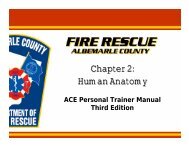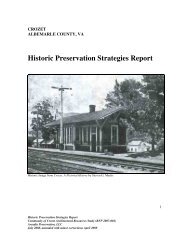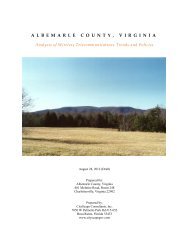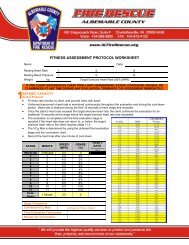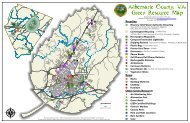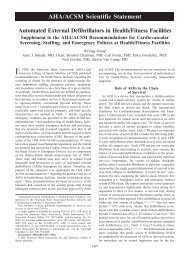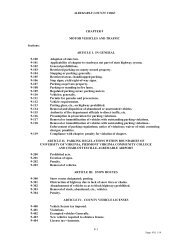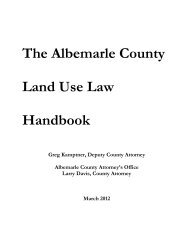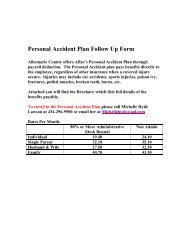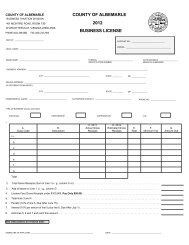Proposed Critical Slopes Ordinance Change - Albemarle County
Proposed Critical Slopes Ordinance Change - Albemarle County
Proposed Critical Slopes Ordinance Change - Albemarle County
You also want an ePaper? Increase the reach of your titles
YUMPU automatically turns print PDFs into web optimized ePapers that Google loves.
The current ordinance regulates the use of certain steep slopes called critical slopes. Any slope of 25%<br />
or greater (a rise or fall of 1 foot in a 4 foot run or approximately 14 degrees) is defined as a critical<br />
slope. Disturbance of a critical slope to establish any use requiring a building permit or site plan is not<br />
permitted unless the activity is one of the listed exempt activities or the Board of Supervisors grants a<br />
special exception. When disturbance is permitted, the current ordinance has no design standards that<br />
apply specifically to steep slopes.<br />
The proposed ordinance would still regulate activity on all slopes of 25% or greater. There would be no<br />
increase or decrease in the regulated areas. The proposal is to have two classes of slopes; “preserved”<br />
and “managed” and to establish design standards. Criteria were developed to determine which<br />
designation a steep slope area should carry. The criteria are not absolute as sometimes a specific area<br />
may have multiple characteristics.<br />
Factors which tend to designate an area as Preserved or Managed:<br />
Preserved <strong>Slopes</strong><br />
• The slopes are a contiguous area of 10,000<br />
square feet or more or a close grouping of<br />
slopes less than 10,000 square feet.<br />
• The slopes are part of a system of slopes<br />
associated with a water feature.<br />
• The slopes are part of a hillside system.<br />
• The slopes are identified as a resource in<br />
the Open Space Plan.<br />
• The slopes are identified as a resource in<br />
the Comprehensive Plan.<br />
• The slopes may be of significant value to<br />
the Entrance Corridor District.<br />
Managed <strong>Slopes</strong><br />
• The contiguous area of critical slopes is<br />
limited or fragmented.<br />
• The slopes are not associated with a water<br />
feature.<br />
• The slopes are not natural.<br />
• The slopes have been significantly<br />
disturbed prior to June 1, 2012.<br />
• The slopes are located within previously<br />
approved single family residential lots.<br />
• The slopes are shown to be disturbed by a<br />
prior <strong>County</strong> action.<br />
• The slopes are shown to be preserved by a<br />
prior <strong>County</strong> action.<br />
Staff has prepared maps showing the proposed designation of Preserved and Managed slopes. These<br />
maps are available by clicking here.<br />
Under the proposed ordinance areas designated as preserved slopes may not be disturbed except for<br />
certain permitted activities. Permitted by right activities include: Construction of the first dwelling on an<br />
existing lot if no other area is available, expansion of existing structures, establishment of public facilities<br />
necessary to use the property provided that development criteria is met, establish of biking and<br />
pedestrian trails, establishment of accessory uses to existing dwellings. Permitted activities by special
use permit include the establishment of private facilities necessary to the use of the property.<br />
Disturbing managed slopes would be permitted provided that design standards are met. The design<br />
standards are intended to allow use of steep areas without the use of excessively tall retaining walls,<br />
minimizing runoff and siltation from newly constructed slopes, maintaining visual quality and minimizing<br />
impacts on abutting properties.<br />
The proposed ordinance does not:<br />
1. Increase or decrease the areas regulated.<br />
2. Reduce environmental protection.<br />
3. Increase costs to applicants or the <strong>County</strong>.<br />
Benefits of the proposed ordinance:<br />
FAQs<br />
1. Predictability. All parties will know which areas may be disturbed and which may not.<br />
2. Establishes design standards to insure that the <strong>County</strong>’s resources are protected. These<br />
resources include protection of water resources and scenic resources.<br />
3. Allows for efficient use of designated development areas potentially decreasing the need to<br />
expand the development areas.<br />
4. Saves the taxpayers of the <strong>County</strong> approximately $24,000 to $56,000 a year in estimated cost<br />
associated with the processing of special exception requests. (These figures are based on<br />
historical costs between 2005 and 2012 associated with the processing of special exceptions.)<br />
5. Allows existing residential lots to expand use their property without first applying for a special<br />
exception. It must be reinforced that special exceptions are discretionary and approval is not<br />
guaranteed.<br />
6. Establishes criteria for determination of exempt activities.<br />
- How do I tell how much of my property is affected by <strong>Critical</strong> <strong>Slopes</strong><br />
- How do I determine if the slopes are proposed to be designated as Preserved or Managed<br />
- Will I be able to build an addition to my house<br />
- Will I be able to build a house on a vacant residential lot<br />
- Will I be able to build a shed on my property<br />
- Can I grade my property to put in terraces<br />
- How can Preserved slopes be disturbed<br />
- Will the proposed ordinance affect my ability to subdivide<br />
- Does the proposed ordinance increase the areas subject to regulation<br />
- How can I request that slopes be designated as Managed instead of Preserved<br />
- How can I request that slopes be designated as Preserved instead of Managed<br />
- How can I remove slopes from being designated as either Managed or Preserved<br />
- What impact does the proposed amendment have on previously approved projects<br />
- What happens to newly created steep slopes<br />
- What happens when field run topography indicates slopes are different from the <strong>County</strong>’s<br />
mapping
- How do I tell how much of my property is affected by <strong>Critical</strong> <strong>Slopes</strong><br />
o <strong>Critical</strong> <strong>Slopes</strong> on every parcel are mapped in the <strong>County</strong>’s GIS system.<br />
http://gisweb.albemarle.org/GISWeb/Welcome.aspx<br />
By entering your address you will be able view your property. If your property has not<br />
been addressed you can enter the owners name or the Tax Map and Parcel number.<br />
Once the parcel has been found, select “<strong>Critical</strong> Resource Plan”. The critical slopes on<br />
the property will be shaded.<br />
- How do I determine if the slopes are proposed to be designated as Preserved or Managed<br />
o Staff has prepared maps showing the proposed designations. These maps may be found<br />
by clicking the link below:<br />
• Crozet<br />
• Hollymead<br />
• Neighborhoods 1-2<br />
• Neighborhoods 4-7<br />
• Pantops<br />
• Piney Mountain<br />
• Rivanna<br />
- Will I be able to build an addition to my house<br />
o The staff proposal is that additions will be permitted in both Preserved and Managed<br />
areas. The design standards for the resulting grading will need to be followed.<br />
Back to FAQs<br />
- Will I be able to build a house on a vacant residential lot<br />
o The staff proposal is that no residential lot will be rendered unbuildable due to the<br />
changes in the ordinance. If area is available outside of Preserved or Managed slopes<br />
for the construction of the house that area must be used. If no area is available outside<br />
of Preserved or Managed <strong>Slopes</strong> then those areas may be used.<br />
- Will I be able to build a shed on my property<br />
o The staff proposal is that sheds will be permitted in both Preserved and Managed areas.<br />
The design standards for the resulting grading will need to be followed.<br />
- Can I grade my property to put in terraces<br />
o The staff proposal is that grading for terraces will be permitted in both Preserved and<br />
Managed areas. The design standards for the resulting grading will need to be followed.<br />
- How can Preserved slopes be disturbed<br />
o The staff proposal includes some exempt activities that may occur on Preserved slopes<br />
provided that standards are met. These activities include things such as utilities and<br />
trails. Any proposal for a non-exempt activity would not be permitted unless the Board<br />
of Zoning Appeals grants a variance based on hardship.<br />
- Will the proposed ordinance affect my ability to subdivide<br />
o The proposed ordinance has no impact on subdivision beyond the existing regulations.<br />
Back to FAQs
- Does the proposed ordinance increase the areas subject to regulation<br />
o No. It also does not decrease the areas subject to regulation.<br />
- How can I request that slopes be designated as Managed instead of Preserved<br />
o Prior to adoption of the ordinance you can contact staff and make a request. You are<br />
also encouraged to speak at the Planning Commission and Board of Supervisors public<br />
hearings. After adoption of the ordinance the property owner may file a rezoning<br />
request which will be heard by the Planning Commission and Board of Supervisors.<br />
- How can I request that slopes be designated as Preserved instead of Managed<br />
o Prior to adoption of the ordinance you can contact staff and make a request. You are<br />
also encouraged to speak at the Planning Commission and Board of Supervisors public<br />
hearings. After adoption of the ordinance the property owner may file a rezoning<br />
request which will be heard by the Planning Commission and Board of Supervisors.<br />
Back to FAQs<br />
- How can I remove slopes from being designated as either Managed or Preserved<br />
o Prior to adoption of the ordinance you can contact staff and make a request. You are<br />
also encouraged to speak at the Planning Commission and Board of Supervisors public<br />
hearings. After adoption of the ordinance the property owner may file a rezoning<br />
request which will be heard by the Planning Commission and Board of Supervisors.<br />
- What impact does the proposed amendment have on previously approved projects<br />
o Approved Site Plans and Subdivisions plats are not impacted by any change in the<br />
Zoning <strong>Ordinance</strong> for as long as the Site Plan or Subdivision approval remains valid.<br />
- What happens to newly created steep slopes<br />
o When grading results in new slopes of 25% or greater they will be subject to the critical<br />
slopes regulations that currently exist.<br />
- What happens when field run topography indicates slopes are different from the <strong>County</strong>’s<br />
mapping<br />
o The standard now, and proposed in this text amendment, is to use the <strong>County</strong> mapping<br />
as the default for determining the location of steep slopes. Under the current<br />
regulations if an applicant performs field run topography that shows the slope is less<br />
than 25%, the <strong>County</strong> accepts that information and the critical slope regulations<br />
automatically do not apply. Under the proposed regulations the slopes would still be<br />
protected unless the applicant submits a rezoning and the rezoning is approved by the<br />
Board of Supervisors.<br />
Back to FAQs
Draft <strong>Proposed</strong> <strong>Ordinance</strong> – 7/10/13<br />
3.1 Definitions<br />
<strong>Critical</strong> slopes: <strong>Slopes</strong> other than managed slopes or preserved slopes of twenty-five (25) percent or<br />
greater as determined by reference to either current topographic mapping available from the county or<br />
a more accurate field survey certified by a professional surveyor or engineer. <strong>Slopes</strong> of twenty-five (25)<br />
percent or greater created as the result of lawfully approved development shall not be considered<br />
critical slopes. (Added 7-11-12)<br />
Managed <strong>Slopes</strong>: The term Managed <strong>Slopes</strong> means any slope shown as a Managed Slope on a map<br />
adopted by the <strong>Albemarle</strong> <strong>County</strong> Board of Supervisors.<br />
Preserved <strong>Slopes</strong>: The term Preserved <strong>Slopes</strong> means any slope shown as a Preserved Slope on a map<br />
adopted by the <strong>Albemarle</strong> <strong>County</strong> Board of Supervisors.<br />
<strong>Critical</strong> <strong>Slopes</strong> Overlay District<br />
30.7.1 Purpose and Intent<br />
• The purpose of this section is to establish as an overlay district property within the development<br />
areas of <strong>Albemarle</strong> <strong>County</strong> which have steep slopes and for which additional development<br />
design care and consideration must be given, prior to the development occurring. The intent of<br />
this district is also to establish development design standards, which will protect the integrity of<br />
the steep slope areas, resulting in development, which will enhance and preserve the character<br />
and beauty of the steep slope areas of the county. This section recognizes that not all steep<br />
slopes have the same limitations for development. Therefore, two categories of steep slopes<br />
are established; Preserved and Managed:<br />
• Preserved slopes are those slopes that have characteristics that warrant their<br />
preservation by the prohibition of disturbance except in the limited circumstances set<br />
out in this ordinance. The characteristics of Preserved slopes are:<br />
• The slopes are a contiguous area of 10,000 square feet or more or a close<br />
grouping of slopes less than 10,000 square feet.<br />
• The slopes are part of a system of slopes associated with a water feature.<br />
• The slopes are part of a hillside system.<br />
• The slopes are identified as a resource in the Open Space Plan.<br />
• The slopes are identified as a resource in the Comprehensive Plan.<br />
• The slopes may be of significant value to the Entrance Corridor District.<br />
• The slopes are shown to be preserved by a prior <strong>County</strong> action.
30.7.2 Permitted Uses<br />
• Managed <strong>Slopes</strong> are those where development may occur provided that design<br />
standards are met to mitigate the impacts caused by the disturbance of the slopes. The<br />
characteristics of Managed <strong>Slopes</strong> are:<br />
• The contiguous area of critical slopes is limited or fragmented.<br />
• The slopes are not associated with a water feature.<br />
• The slopes are not natural.<br />
• The slopes have been significantly disturbed prior to June 1, 2012.<br />
• The slopes are located within previously approved single family residential lots.<br />
• The slopes are shown to be disturbed by a prior <strong>County</strong> action.<br />
a. Managed <strong>Slopes</strong><br />
1. Uses permitted by right in the underlying zoning district shall be permitted by<br />
right in the <strong>Critical</strong> <strong>Slopes</strong> overlay district provided that the disturbance to<br />
establish such use complies with the <strong>County</strong> Code and the design standards<br />
contained in 30.7.3.<br />
2. Any lot or parcel of record which was lawfully a lot of record on DATE OF<br />
ADOPTION may establish the first single-family detached dwelling unit on such<br />
lot or parcel; provided the parcel does not contain adequate land area outside<br />
of managed slopes for the location of such structure. For the purposes of this<br />
section, the term "lawfully a lot of record" shall also apply to any lot shown on a<br />
subdivision plat approved prior to DATE OF ADOPTION, provided such plat has<br />
not expired. Any disturbance to establish the first single-family detached<br />
dwelling shall comply with the design standards contained in 30.7.3.<br />
b. Preserved <strong>Slopes</strong><br />
1. The following uses are permitted by right on Preserved <strong>Slopes</strong> provided that the<br />
disturbance complies with the <strong>County</strong> Code and the design standards contained<br />
in 30.7.3.<br />
i. Any structure which was lawfully in existence prior to DATE OF<br />
ADOPTION may be expanded, enlarged, extended, modified and/or<br />
reconstructed. For the purposes of this section, the term "lawfully in<br />
existence" shall also apply to any structure for which a site development<br />
plan was approved or a building permit was issued prior to DATE OF<br />
ADOPTION, provided such plan or permit has not expired.
ii. Any lot or parcel of record which was lawfully a lot of record on DATE<br />
OF ADOPTION may establish the first single-family detached dwelling<br />
unit on such lot or parcel; provided the parcel does not contain<br />
adequate land area in outside of preserved slopes for the location of<br />
such structure. For the purposes of this section, the term "lawfully a lot<br />
of record" shall also apply to any lot shown on a subdivision plat<br />
approved prior to DATE OF ADOPTION, provided such plat has not<br />
expired.<br />
iii. Public facilities necessary to allow the use of the parcel provided that<br />
any of the following factors apply:<br />
1. The disturbance avoids impacts on other protected resources<br />
such as stream buffers or floodplain.<br />
2. The alignment is consistent with facilities included in the<br />
Comprehensive Plan.<br />
3. The disturbance is necessary to provide interconnection<br />
required by the <strong>County</strong> Code or the regulations of other<br />
agencies.<br />
4. Literal enforcement of the provision will result in unnecessary<br />
hardship.<br />
5. The exceptional narrowness, shallowness, size or shape of a<br />
specific piece of property at the time of the effective date of<br />
this ordinance, the strict application of the terms of this<br />
ordinance would effectively prohibit or unreasonably restrict<br />
the use of the property.<br />
iv. Public or Private pedestrian and cycling trails.<br />
v. Accessory uses to dwellings lawfully in existence prior to DATE OF<br />
ADOPTION.<br />
2. The following uses shall be permitted by special use permit.<br />
a. Private facilities such as accesways, utility lines and appurtenances and<br />
stormwater management facilities necessary to allow the use of the parcel
30.7.3 Design Standards<br />
a. The maximum height for a single retaining wall, measured from grade to grade, shall be 6<br />
feet. When the overall retained height would exceed 6 feet, the retaining wall shall be<br />
broken into multiple stepped walls.<br />
1. A minimum horizontal distance of 3 feet shall be maintained between each<br />
individual wall in the stepped wall system, and shall be landscaped with screening<br />
shrubs planted on 10 foot centers.<br />
2. Retaining walls may be incorporated into the design of a structure so that they<br />
become part of the structure. Retaining walls incorporated into the design of a<br />
structure shall not be subject to limitations in height.<br />
b. Cuts and fills shall be rounded off to eliminate sharp angles at the top, bottom and side of<br />
regraded slopes.<br />
c. The toe of the fill slope shall not be located within 10 feet horizontally of the top of an<br />
existing or proposed cut slope.<br />
d. Tops and bottoms of cut and fill slopes shall be set back from existing and proposed<br />
property lines a distance at least equal to the lesser of three feet plus 1/5 of the height of<br />
the cut or fill, or 10 feet.<br />
e. Cut and fill slopes shall not be steeper than 2:1 (fifty (50) percent). Where the slope is to be<br />
mowed, the slope shall be no steeper than 3:1 (thirty three (33) percent.<br />
f. Reverse slope benches or diversion shall be provided whenever the vertical interval (height)<br />
of any 2:1 (fifty (50) percent) slope exceeds 20 feet; for 3:1 (thirty three (33) percent) slope<br />
it shall be increased to 30 feet and for 4:1 (twenty- five (25) percent) to 40 feet.<br />
1. Benches shall be located to divide the slope face as equally as possible and shall<br />
convey the water to a stable outlet.<br />
2. Benches shall be a minimum of six feet wide to provide.<br />
3. Benches shall be designed with a reverse slope of 6:1 (seventeen (17) percent) or<br />
flatter to the toe of the upper slope and with a minimum of one foot in depth.<br />
Bench gradient to the outlet shall be between 2 percent and 3 percent, unless<br />
accompanied by appropriate design and computations.<br />
4. The flow length within a bench shall not exceed 800 feet unless accompanied by<br />
appropriate design and computations.<br />
g. Surface water shall be diverted from the face of all cut and/or fill slopes by the use of<br />
diversions, ditches and swales or conveyed downslope by the use of a designed structure.<br />
The face of the slope shall not be subject to any concentrated flows of surface water such as<br />
from natural drainage ways, graded swales, downspouts, etc.
h. Subsurface drainage shall be provided where deemed necessary by the <strong>County</strong> Engineer to<br />
intercept seepage that would otherwise adversely affect slope stability or create excessively<br />
wet site conditions.<br />
30.7.6 Amendment of <strong>Critical</strong> <strong>Slopes</strong> Overlay District<br />
a. The delineation of the critical slopes overlay district may be revised, amended and modified by<br />
the board of supervisors after application is made by the owner in accord with the provisions of<br />
section 33 provided that the application includes field run topography prepared by a licensed<br />
engineer, surveyor or landscape architect indicating that the area does not include slopes of<br />
25% or greater. or,<br />
b. The delineation of the critical slopes overlay district may be revised, amended and modified by<br />
the board of supervisors after application is made by the owner in accord with the provisions of<br />
section 33.<br />
35.1 FEES.<br />
Each applicant shall pay the following applicable fees, provided that neither the county nor the county<br />
school board shall be required to pay any fee if it is the applicant:<br />
b. Zoning map amendments:<br />
1. Less than 50 acres; application and first resubmission: $2500.00<br />
2. Less than 50 acres; each additional resubmission: $1250.00<br />
3. 50 acres or greater; application and first resubmission: $3500.00<br />
4. 50 acres or greater; each additional resubmission: $1750.00<br />
5. Deferral of scheduled public hearing at applicant’s request: $180.00<br />
6. No fee shall be required for applications submitted in accord with section 30.7.6(a).<br />
j. Required notice:<br />
1. Preparing and mailing or delivering up to fifty (50) notices: $200.00, except for uses under sections<br />
5.1.47 and 5.2A, or applications submitted in accord with section 30.7.6(a), for which there shall be no<br />
fee.<br />
2. Preparing and mailing or delivering, per notice more than fifty (50): $1.00 plus the actual cost of first<br />
class postage. No fee shall be required for applications submitted in accord with section 30.7.6(a)<br />
3. Published notice: cost based on a cost quote from the publisher, except for farmers’ markets under<br />
section 35.1(c) (7) and (8) or applications submitted in accord with section 30.7.6(a) for which there shall<br />
be no fee.




